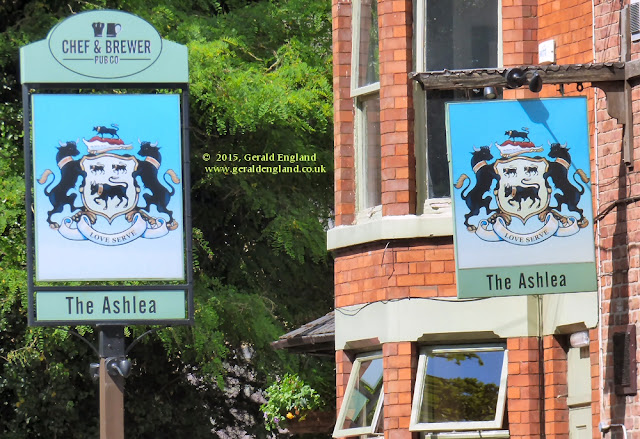A follow-up to my posts from
29th June 2015 featuring panals 1 -4 of the Running Man Mural; the post of
6th July 2016 featuring panals 5 - 6 and the post of
13th July 2015 featuring panels 9 - 12. The 16 panel mural was the work of the group
Friends of Heaton Chapel Station and produced with support from the local community.
Panel 13 was sponsored by Vital Signs and Graphics and designed with pupils at Norris Bank Primary School - Heaton Norris.
Panel 14 was sponsored by Stella Maris School and carries a statement from Northern Rail:
As one of the biggest train operators in Britain, Northern Rail provides 2,500 local and regional train services every day across the north of England, serving a population of nearly 15 million.
We pride ourselves on offering consistent and local train services to our customers, as they make their way around our network to visit the wide variety of things to do and places to see in the areas we operate.
Northern Rail is proud to be at the heart of the railways and we work closely with local community groups to help enhance our stations and their surroundings.
Having worked with 'Friends of Heaton Chapel Station' since August 2011, we've seen the station blossom thanks to the great efforts made by this partnership.
Panel 15 informs us:
From the early 13th century, Heaton Norris was a sub-manor of Manchester, encompassing all of the Four Heatons including Heaton Moor which was mainly moss land (peat bog) with rich agricultural land that supported mixed farming.
In 1837 Parliamentary approval was given for the railway to by built by the Manchester and Birmingham Railway, the first section from Heaton Norris to Manchester opening in 1841.
Heaton Chapel Station was built in 1851 close to the St. Thomas Rectory and not according to some railway company's grand plan but largely at the instigation of a local clergyman, Edward Jackson of St Thomas Church in Heaton Chapel.
Before entering the church, he had been a master at Manchester Grammar School and when he discovered that one of his former pupils was the superintendent of the northern division of the LNWR, he was determined to use his influence and put Heaton Chapel on the railway map. This was quite a tall order: even if all the arguments are on your side, because building a station in a deep cutting presents difficulties, (there are 43 steps to the platform on northbound platform 2).
However Rev. Jackson won the day, his old pupil complied and Heaton Chapel was the triumphant result. The opening of the station had am immediate effect on the surrounding area which became a fashionable address for those who could afford to live in the leafy suburbs and commute to Manchester by train. Land was acquired and roads were planned. The houses, villas and new buildings along Heaton Moor Road were of a grandiose scale with generous gardens.
Sadly, Joseph Swindlehurst, the stationmaster in the 1890s would no longer be able to recognise his beloved station.
Panel 16 was sponsored by 4 Heatons Traders Association and informs us:
The artwork was designed by local artist Karen Allerton with photographs and historic information supplied by Phil Rowbotham ©
Two members of Sustainable Living in the Heatons, a local community group, explored the possibility of developing an art protect on the northbound platform of the station in June 2011 with a burning passion to change the tired salmon wall. As a result of the discussions we formed the Friends of Heaton Chapel Station in August 2011, with the principal aim of making the station a more attractive place.
Out enthusiastic group began work during the autumn cutting and cleaning beds on the Stockport bound platform and planted flowers, herbs and plants which have now blossomed this spring, We also set up a library in the ticket office which has proved really successful with travellers.
With the help of materials and paint from Northern Rail and a great bunch of volunteers, we painted the wall black in preparation for the artwork. We have engaged with various groups in the Heatons community and would like to thank them and all the local businesses that have sponsored this great undertaking. Additionally, we are indebted to the local primary schools who have worked with us on the project.
A contribution to
Monday Murals.




























